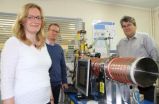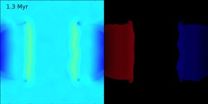(Press-News.org) Some 40 scientists and technicians from around the world will descend on Jordan in November to take part in a simulated on-site inspection of a suspected nuclear test site on the banks of the Dead Sea.
Playing the part of inspectors, the experts will have access to a wide range of sensor technologies to look for signs of whether a nuclear explosion has taken place. At the same time, other role-players representing the state under inspection will try to put them off their scent.
The aim of this elaborate exercise, as science writer Edwin Cartlidge explains in this month's Physics World, is to prepare for the on-site inspections foreseen under the Comprehensive Nuclear-Test-Ban Treaty (CTBT). Opened for signature in 1996, this agreement bans all signatory nations from carrying out nuclear tests anywhere on Earth or in space.
The CTBT has been signed by more than 180 nations to date, but to become legally binding all 44 countries that possessed nuclear technology in 1996 must sign it and then ratify it, which typically means that their parliaments must approve it in a vote. However, eight of those countries, including North Korea and the US, have still to do so.
Until the CTBT gets the backing of all the relevant nations, scientists cannot perform the final and crucial part of the verification regime specified in the treaty: on-site inspection, which would be invoked following initial evidence of any nuclear testing provided by a global network of sensors known as the International Monitoring System (IMS).
In the article, Cartlidge explains in more detail the role that the IMS's 279 facilities currently play in detecting four types of physical phenomena than can provide evidence of a nuclear explosion having taken place.
Data produced by measuring these phenomena – seismic waves, radioactive nuclei, underwater sound waves and infrasonic waves – are continually sent in near real-time to the Comprehensive Nuclear-Test-Ban Treaty Organization (CTBTO) in Vienna, Austria, where they are pieced together and used to look for any suspicious or unnatural events.
"Unfortunately, the evidence from the IMS is not always enough to convince signatories of the CTBT that a nuclear test has taken place. The network did not, for example, detect any radionuclides following a test North Korea carried out in 2009, and it was nearly two months before stations in Japan and Russia picked up radioactive noble gases after [North Korea's] 2013 test," Cartlidge writes.
Once the experts arrive at the roughly 1000 km2 of mountainous desert and scrubland in Jordan, they will have access to almost all of the sensor technologies available to them under the terms of the CTBT, including ultraviolet light to search for vehicle tracks in the dirt, infrared radiation to hunt down the exact point of any possible explosion, and noble-gas detection systems to measure the telltale gases xenon and argon.
"While the treaty remains on hold, CTBTO scientists will continue to refine and test their monitoring techniques, ensuring that they are as ready as they can be should they finally be called upon to investigate what could be the explosion of a real nuclear weapon. "The exercise in Jordan should provide a stern test of that preparedness," Cartlidge concludes.
Also in this issue:
Pointless or profound? -- The search for "sterile" neutrinos
The ultimate job -- What it really takes to be CERN boss
Cosmic discovery -- How Einstein studied the steady state
INFORMATION:
Please mention Physics World as the source of these items and, if publishing online, please include a hyperlink to: http://physicsworld.com
Notes for editors:
1. Physics World is the international monthly magazine published by the Institute of Physics. For further information or details of its editorial programme, please contact the editor, Dr Matin Durrani, tel +44 (0)117 930 1002. The magazine's website physicsworld.com is updated regularly and contains daily physics news and regular audio and video content. Visit http://physicsworld.com.
2. For copies of the articles reviewed here contact Mike Bishop, IOP Publishing Senior Press Officer, tel: +44 (0)11 7930 1032, e-mail: michael.bishop@iop.org
3. The Institute of Physics is a leading scientific society. We are a charitable organisation with a worldwide membership of more than 50,000, working together to advance physics education, research and application.
We engage with policymakers and the general public to develop awareness and understanding of the value of physics and, through IOP Publishing, we are world leaders in professional scientific communications.
In September 2013, we launched our first fundraising campaign. Our campaign, Opportunity Physics, offers you the chance to support the work that we do.
Scientists get set for simulated nuclear inspection
2014-09-01
ELSE PRESS RELEASES FROM THIS DATE:
Invisible blood in urine may indicate bladder cancer
2014-09-01
New research which finds that invisible blood in urine may be an early warning sign of bladder cancer is likely to shape guidelines for clinicians.
Scientists at the University of Exeter Medical School found that one in 60 people over the age of 60 who had invisible blood in their urine (identified by their GP testing their urine) transpired to have bladder cancer. The figure was around half those who had visible blood in their urine – the best known indicator of bladder cancer. However, it was still higher than figures for other potential symptoms of bladder cancer ...
Sugar substance 'kills' good HDL cholesterol, new research finds
2014-09-01
Scientists at the University of Warwick have discovered that 'good' cholesterol is turned 'bad' by a sugar-derived substance.
The substance, methylglyoxal - MG, was found to damage 'good' HDL cholesterol, which removes excess levels of bad cholesterol from the body.
Low levels of HDL, High Density Lipoprotein, are closely linked to heart disease, with increased levels of MG being common in the elderly and those with diabetes or kidney problems.
Supported by funding from the British Heart Foundation (BHF) and published in Nutrition and Diabetes, the researchers ...
New tuberculosis blood test in children is reliable and highly specific
2014-09-01
A new blood test provides a fast and accurate tool to diagnose tuberculosis in children, a new proof-of-concept study shows. The newly developed test (TAM-TB assay) is the first reliable immunodiagnostic assay to detect active tuberculosis in children. The test features excellent specificity, a similar sensitivity as culture tests in combination with speed of a blood test. The promising findings are a major advance for the diagnosis of tuberculosis in children, particularly in tuberculosis-endemic regions.
The study has been published on Sept 1st, 2014 in Lancet Infectious ...
Scientists develop 'electronic nose' for rapid detection of C. diff infection
2014-09-01
A fast-sensitive "electronic-nose" for sniffing the highly infectious bacteria C. diff, that causes diarrhoea, temperature and stomach cramps, has been developed by a team at the University of Leicester.
Using a mass spectrometer, the research team has demonstrated that it is possible to identify the unique 'smell' of C. diff which would lead to rapid diagnosis of the condition.
What is more, the Leicester team say it could be possible to identify different strains of the disease simply from their smell – a chemical fingerprint - helping medics to target the particular ...
Why plants in the office make us more productive
2014-09-01
'Green' offices with plants make staff happier and more productive than 'lean' designs stripped of greenery, new research shows.
In the first field study of its kind, published today, researchers found enriching a 'lean' office with plants could increase productivity by 15%.
The team examined the impact of 'lean' and 'green' offices on staff's perceptions of air quality, concentration, and workplace satisfaction, and monitored productivity levels over subsequent months in two large commercial offices in the UK and The Netherlands.
Lead researcher Marlon Nieuwenhuis, ...
Doctor revalidation needs to address 7 key issues for success, claims report
2014-09-01
New research launched today, 1st September 2014, has concluded that there are seven key issues that need to be addressed to ensure the future success of doctor revalidation, the most profound revision in medical regulation since the Medical Act of 1858.
The research has been funded by the Health Foundation, an independent health care charity, as part of a long-term programme looking at different aspects of revalidation. The work has been carried out by academics at the Collaboration for the Advancement of Medical Education, Research and Assessment (CAMERA) at Plymouth ...
Memory in silent neurons
2014-08-31
When we learn, we associate a sensory experience either with other stimuli or with a certain type of behaviour. The neurons in the cerebral cortex that transmit the information modify the synaptic connections that they have with the other neurons. According to a generally-accepted model of synaptic plasticity, a neuron that communicates with others of the same kind emits an electrical impulse as well as activating its synapses transiently. This electrical pulse, combined with the signal received from other neurons, acts to stimulate the synapses. How is it that some neurons ...
A new synthetic amino acid for an emerging class of drugs
2014-08-31
One of the greatest challenges in modern medicine is developing drugs that are highly effective against a target, but with minimal toxicity and side-effects to the patient. Such properties are directly related to the 3D structure of the drug molecule. Ideally, the drug should have a shape that is perfectly complementary to a disease-causing target, so that it binds it with high specificity. Publishing in Nature Chemistry, EPFL scientists have developed a synthetic amino acid that can impact the 3D structure of bioactive peptides and enhance their potency.
Peptides and ...
Discovery reveals how bacteria distinguish harmful vs. helpful viruses
2014-08-31
When they are not busy attacking us, germs go after each other. But when viruses invade bacteria, it doesn't always spell disaster for the infected microbes: Sometimes viruses actually carry helpful genes that a bacterium can harness to, say, expand its diet or better attack its own hosts.
Scientists have assumed the bacterial version of an immune system would robotically destroy anything it recognized as invading viral genes. However, new experiments at Rockefeller University have now revealed that one variety of the bacterial immune system known as the CRISPR-Cas system ...
Why sibling stars look alike: Early, fast mixing in star-birth clouds
2014-08-31
VIDEO:
This 11-second movie shows a computational simulation of a collision of two converging streams of interstellar gas, leading to collapse and formation of a star cluster at the center. Face-on...
Click here for more information.
Stars are made mostly of hydrogen and helium, but they also contain trace amounts of other elements, such as carbon, oxygen, iron, and even more exotic substances. By carefully measuring the wavelengths (colors) of light coming from a star, astronomers ...



